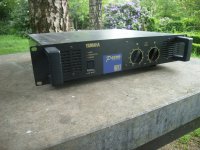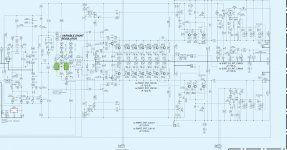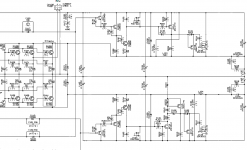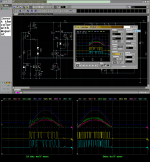I have heard about power amps from Yamaha, EEEngine technology inside.
Really the absolute "State of the Art" circuit?
Are there already diy projects on the web where this topology is in use?
Here some URL's:
Yamaha Commercial Audio | What?s EEEngine?
EEEngine | Self Training | Training | Yamaha Pro Audio
http://www.yamahaproaudio.com/downloads/documents/data/white_papers/yamahapoweramp_whitepaper_en.pdf
http://www.yamahacommercialaudio.co...mplifier/product_index/50_eeengine/index.html (German)
http://www.yamahacommercialaudio.co...r_interviews/archive/2007_03/27_Tn/index.html (German)
Really the absolute "State of the Art" circuit?
Are there already diy projects on the web where this topology is in use?
Here some URL's:
Yamaha Commercial Audio | What?s EEEngine?
EEEngine | Self Training | Training | Yamaha Pro Audio
http://www.yamahaproaudio.com/downloads/documents/data/white_papers/yamahapoweramp_whitepaper_en.pdf
http://www.yamahacommercialaudio.co...mplifier/product_index/50_eeengine/index.html (German)
http://www.yamahacommercialaudio.co...r_interviews/archive/2007_03/27_Tn/index.html (German)
Attachments
Last edited:
we do have a Class D sub forum but in gerneral why would you expect DIYers to be interested when you need pro engineering skills and tools and a free man-year or so for something of that compelxity?
in return for at best managing to control switching nosie to not mess up a good AB design?
applying more iron, copper and aluminum in a analog design are lots cheaper than the time, extra tools and expertise
also the shortest path for a DIYer to "beat" common commercial systems is to use BiAmping with smaller wattage, lower peak current demands on each amp
in return for at best managing to control switching nosie to not mess up a good AB design?
applying more iron, copper and aluminum in a analog design are lots cheaper than the time, extra tools and expertise
also the shortest path for a DIYer to "beat" common commercial systems is to use BiAmping with smaller wattage, lower peak current demands on each amp
The Labgruppen FP3400 schematics you can download form here
Categorized Schematics and Service Manuals for free download I-N
And I attached Yamaha T3n power amp with EEEngine
And maybe this has something to to with this Yamaha patent
Amplification circuit
Categorized Schematics and Service Manuals for free download I-N
And I attached Yamaha T3n power amp with EEEngine
And maybe this has something to to with this Yamaha patent
Amplification circuit
Attachments
Last edited:
Yamaha regulator is based on linear regulator plus current source to help it.
The current source (self oscillating) work to supply almost amplifier current requirement. The result is stable low ripple voltage, fast response, and high efficiency.
Yamaha did a good work.
The current source (self oscillating) work to supply almost amplifier current requirement. The result is stable low ripple voltage, fast response, and high efficiency.
Yamaha did a good work.
Last edited:
i belive that the idea is the same with Bob Carver the true sub from sunfire was based on this topology if i remember well ....only legend BOB was thinking about this almost 20 years ago ....
I wonder where is BOB now days ...i think he was terrible when it comes to bussines but otherwise a true mastermind
I wonder where is BOB now days ...i think he was terrible when it comes to bussines but otherwise a true mastermind
I know about the ClassD forum - nevertheless I have filed here instead there, because this is a mixture of various topologies and not a pure Class-D (at least for me). Additional here comes more visitors than about the subfile "Class-D" and as I start this thread I don't know about it's compelxity (but now I know this).we do have a Class D sub forum but in gerneral why would you expect DIYers to be interested when you need pro engineering skills and tools and a free man-year or so for something of that compelxity?
The aim for start this thread isn't the needing of pro engineering advices. The aim is only to get basic informations, the degree of establishing in the marked and opinions about this topology.
jony: thank you very much for this URL and the schema.
Last edited:
well i never follow your posts my dear german friend for a number of reasons ... one of them is that your posts include so many links ( probably usefull ) but god the thing is getting too long .... another think is that my english is ok and my german simply dont exist so yes it is very strange for me to talk with someone that is called tiebassuedertr.... was it something wrong with John or Jim ????
beyond a joke i think you are very right this post belongs here since its not class D to my understanding also
to make this more simple to understand i will post one link of the sunfire white paper where Bob is talking about his 1990 dream and how he made it practice
http://www.sunfire.com/whitepapers/Sunfire_Amplifier_Whitepaper.pdf
beyond a joke i think you are very right this post belongs here since its not class D to my understanding also
to make this more simple to understand i will post one link of the sunfire white paper where Bob is talking about his 1990 dream and how he made it practice
http://www.sunfire.com/whitepapers/Sunfire_Amplifier_Whitepaper.pdf
a bit of off topic
a bit offtopic
one word for BOB .... once i talked with bob over the phone about one issue for a legend he was actually a very "landed " guy to listen to very willing to understand and share a vision with me
later on he supported my idea with documentation and e mails
it is not realy importand if the idea put in practice or make money with but still his behaviour was polite and helpfull beyond any expectation ...
way to go Bob .... thanks ...
a bit offtopic
one word for BOB .... once i talked with bob over the phone about one issue for a legend he was actually a very "landed " guy to listen to very willing to understand and share a vision with me
later on he supported my idea with documentation and e mails
it is not realy importand if the idea put in practice or make money with but still his behaviour was polite and helpfull beyond any expectation ...
way to go Bob .... thanks ...
Hi tief, it is not that compelxity(typo). It is simple, more simple than classH drivers.
And this regulator different from both carver and labgrupen. EEEngine regulator is based on linear regulator, unlike the other. This linear regulator working as normal voltage regulator. But there is unstable regulator added to help increasing efficiency by helping the voltage regulator. The unstable regulator help to supply the current needed by amplifier.
This eeengine low power version (XP1000). Lower power version in powered mixers may be simpler.
And this regulator different from both carver and labgrupen. EEEngine regulator is based on linear regulator, unlike the other. This linear regulator working as normal voltage regulator. But there is unstable regulator added to help increasing efficiency by helping the voltage regulator. The unstable regulator help to supply the current needed by amplifier.
This eeengine low power version (XP1000). Lower power version in powered mixers may be simpler.
Attachments
- Home
- Amplifiers
- Solid State
- Class-AB meets Class-D: Yamaha's EEEngine Topology - where are this Diy Projects?



